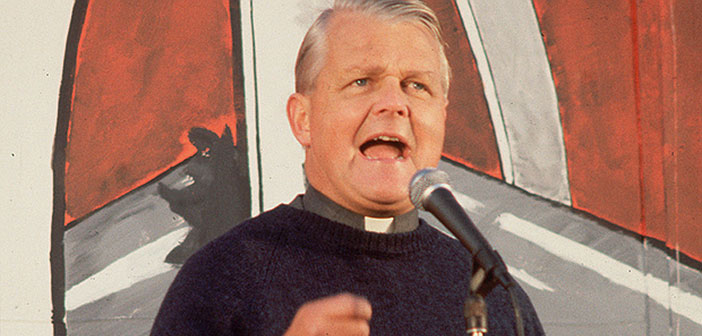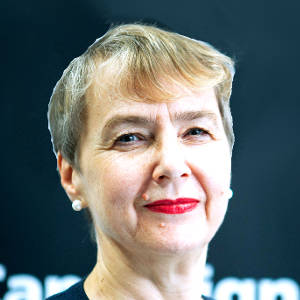
Bruce Kent was remarkable, inspirational and wise, with a great capacity to communicate and motivate across the generations. He has touched so many lives, with his passion for the cause of peace, with his commitment and determination to rid the world of nuclear weapons. The last few days have seen an enormous outpouring of love for this man, reflecting his love for humanity and the powerful principles that he stood by. He had an enormous wealth of experience and knowledge but he never spent time looking to the past; he never said to me, ‘Oh, we did it like this’ or ‘I remember when…’. He was always about what can we do now, about how we go forward. And of course, what could he do to help, to make things happen. Above all, he was man of action, always direct, with a dislike of flannel, but he found time to listen too, to provide encouragement, or solace, or humour.
Bruce became general secretary of CND in 1980. This was a pivotal moment in global politics. The decision had just been taken by western European leaders to let the US bring 572 cruise and pershing missiles to Europe. 160 cruise missiles would go to Britain, with 96 scheduled to arrive at Greenham Common in Berkshire in December 1983, and the other 64 at the Molesworth base in Cambridgeshire by the end of 1986. These were intermediate-range, ground-launched cruise missiles that would much reduce the time it took to hit a Soviet city. Shortly afterwards, the British government also announced that it was going to buy the US Trident missile system as a replacement for Polaris.
There was an immediate and massive public opposition to the coming of cruise missiles – because it was absolutely clear that their presence would mean that a US/Soviet nuclear war would be fought in Europe. In a sense Bruce was thrown in at the deep end, but he responded with massive enthusiasm and clear leadership, harnessing and mobilising the enormous public support. As he wrote subsequently, “Week by week arrived more letters, more membership applications, more callers, more journalists, more requests for speakers, more orders for badges and leaflets … Our two small office rooms, which can’t have amounted to more than 300 square feet in total, were jammed with volunteers… By the end of 1980 we were in new offices, themselves soon becoming too small. New memberships poured in by the hundreds every week. The graph which we had on the wall outgrew the wall and had to be taken across the ceiling.’i”
Between 1979 and 1984, CND’s national membership grew from 4,267 to 90,000. Local membership increased to 250,000, and rallies and protests attracted enormous numbers.ii Hundreds of local groups sprang up – eventually CND had a thousand local groups – and Bruce made the immediate decision to embrace this spontaneous upsurge of groups and activities. Bruce shared CND’s knowledge and experience, and was able to give direction to the mass mobilisations that followed.
Many demonstrations took place across the country in the following years, and Bruce was always there, speaking and inspiring. My first sight of Bruce was across the hundreds of thousands in Hyde Park seeing him as a tiny dot on the stage. There was a particularly massive one in October 1981, with at least quarter of a million present. As Bruce said:
‘The park was full. It was, from the platform, an amazing spectacle, with moving crowds of people as far as the eye could see, right down to the edge of the Serpentine. We claimed 250,000 and that seemed a modest guess to me.’iii
New forms of protest emerged too – in particular the peace camps – and Bruce was keen to develop and be part of these too, linking with the Greenham women at Easter 1983 when, instead of the more traditional march from Aldermaston, a 14-mile human chain was formed, linking Aldermaston and Greenham, via the Royal Ordnance Factory at Burghfield, which was the final assembly point for Britain’s nuclear weapons. Tweets and message over the last few days have shared accounts of Bruce’s visits to Greenham and other peace camps, of his popular deliveries of Mars Bars and other warm and very human kindnesses.
Of course precisely because Bruce was so effective politically and as a mobiliser and motivator, he was also on the receiving end of great hostility, and lies and vitriol, attempting to undermine and destroy the reputation of CND as well as that of Bruce himself. As public support increased, the government put a lot of energy into its anti-CND campaign, much of it focused around suggesting that CND was funded by the Soviet Union. Bruce’s response to this was to offer a prize of £100 to anyone who could produce evidence of Soviet funding. No one came forward to claim the prize, but there were wild accusations, such as that from Lord Chalfont that the Soviet Union were funding the European peace movement to the tune of £100 million a year. ‘If they were’, said Bruce, ‘it was certainly not getting to our grotty little office in Finsbury Park.’iv
From the beginning of 1983, Michael Heseltine was defence secretary and established DS19, a team within the MoD, to organise the campaign against CND. Attention also came from MI5 and Bruce Kent commented that they spied on CND efficiently:
‘But for brave Cathy Massiter, who left the Service and blew the whistle, we might never have known that nice old Harry Newton, who stuffed envelopes as a volunteer, was actually a government informer. Not that there were many secrets to reveal. I used to chat with him over the sink at 11 Goodwin Street, and for my pains he reported me to his superiors as a pseudo -marxist, which sounds even worse than being a real one.’v
A number of attacks came from an organisation called the Coalition for Peace through Security, which disrupted events, sent a spy into the CND office and tried to link Bruce with the IRA. The Coalition opted for slogans like ‘Disarmament equals surrender’, and was endorsed by leading Conservative politicians, who tried to make out that there were links between CND and the Soviet Union. Bruce treated these attacks with the contempt they deserved. Similar dirty tricks continued throughout the general election in 1983, attempting to discredit Michael Foot – a founder of CND – organised by a group called The 61, partly funded by the CIA to operate against peace movements.
After the election, Michael Heseltine announced that CND was dead and buried, but the opposite was true. CND’s membership continued to grow, from 75,000 in 1983 to over 100,000 in 1985, with a paid staff of 40. CND held the largest demonstration in its history in October 1983 with 400,000 in Hyde Park. This continued increase in membership and support was not surprising, given the increasingly tense global situation. Eventually as we know, the balance shifted and the missiles were removed from Europe. By 1991 they were all gone.
The enormous struggle between the peace-loving people and the war mongering politicians was eventually won – and won by the people. There is no doubt that the mass work of CND under Bruce Kent’s leadership, together with the alliances across civil society that he championed, through his broad and inclusive approach, played a very major role in that. Of course Bruce’s work for CND didn’t end with the 1980s. He continued to play a major role in our work, both as a leader and activist – and as our finest and most popular public speaker – until the end. Words cannot express the love and gratitude that our movement holds for the life and work of Bruce Kent. He is always in our hearts.
i Undiscovered Ends, opcit, pp 171-72.
ii Lawrence S Wittner, ‘The Transnational Movement against Nuclear Weapons, 1945-1986: A Preliminary Survey’, in Charles Chatfield and Peter Van Den Dungen (eds), 1988, Peace Movements and Political Cultures, University of Tennessee Press, Knoxville, p 278.
iii Undiscovered Ends, opcit, p 175.
iv Undiscovered Ends, opcit, p 180.
v Ibid.
